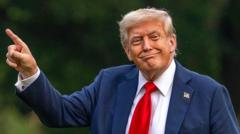The recent trade agreement between the United States and Japan, heralded by President Donald Trump as a monumental achievement, is expected to reshape trade relations not just bilaterally, but also within Asia and beyond. While some skeptics argue it's too soon to label it as the "largest trade deal in history," it undeniably represents a pivotal development since the imposition of tariffs by Trump earlier in the year, which sent shockwaves through global markets and heightened volatility in international trade.
Japan, positioned as the fourth-largest economy globally, plays a crucial role in international commerce, heavily reliant on imports for energy and food while exporting high-profile products such as vehicles, electronics, and machinery. The trade deal is particularly significant for Japan, as the United States remains its largest market. Economists had voiced concerns that the tariffs could significantly hamper Japan's economic growth, leading to potential recession. However, the reduced tariffs under this agreement are expected to enable Japanese exporters to engage more competitively with American markets, fostering economic stability and growth.
Key outcomes of the deal include a progressive reduction in the tariff on Japanese vehicle imports from 27.5% to 15%, which may lead to more affordable pricing of Japanese cars in the American market. This reduction could enhance the competitiveness of Japanese automotive giants like Toyota and Honda, but worries persist among US auto manufacturers who face higher tariff rates on vehicles imported from their facilities in Canada and Mexico.
In return for lowered tariffs, Japan has pledged to invest $550 billion into the United States, with an emphasis on developing supply chains in critical sectors like pharmaceuticals and technology. This investment is anticipated to create jobs and promote innovation within the US economy. The agreement also stipulates increased purchases of American agricultural products, including rice, potentially aiding in addressing domestic shortages while stirring apprehensions among local farmers about market competition.
The implications of this deal extend beyond US-Japan relations; it sets a new standard within Asia, where countries like South Korea and Taiwan may feel compelled to negotiate favorable terms to secure their economic interests. The timing of the deal places pressure on these nations as they approach trade discussions, particularly with a looming August deadline for finalized agreements.
Moreover, the trade deal could disadvantage smaller Asian economies, such as Cambodia and Laos, that lack the capacity to negotiate similar arrangements due to their limited offerings in trade and investment. As the US seeks strategic partnerships, the need for robust agreements becomes increasingly evident.
On the diplomatic front, while some speculated the deal might include military spending commitments from Japan, officials have clarified that no such conditions were included. Existing tariffs on steel and aluminum products remain unchanged, further suggesting that while Japan has secured favorable terms in the automotive sector, it continues to navigate complex global trade dynamics.
As new alliances form, Japan has also been proactive, recently engaging with European leadership to collectively address economic pressure and unfair trade practices, signaling a potential shift in international partnerships amid evolving trade landscapes.
Japan, positioned as the fourth-largest economy globally, plays a crucial role in international commerce, heavily reliant on imports for energy and food while exporting high-profile products such as vehicles, electronics, and machinery. The trade deal is particularly significant for Japan, as the United States remains its largest market. Economists had voiced concerns that the tariffs could significantly hamper Japan's economic growth, leading to potential recession. However, the reduced tariffs under this agreement are expected to enable Japanese exporters to engage more competitively with American markets, fostering economic stability and growth.
Key outcomes of the deal include a progressive reduction in the tariff on Japanese vehicle imports from 27.5% to 15%, which may lead to more affordable pricing of Japanese cars in the American market. This reduction could enhance the competitiveness of Japanese automotive giants like Toyota and Honda, but worries persist among US auto manufacturers who face higher tariff rates on vehicles imported from their facilities in Canada and Mexico.
In return for lowered tariffs, Japan has pledged to invest $550 billion into the United States, with an emphasis on developing supply chains in critical sectors like pharmaceuticals and technology. This investment is anticipated to create jobs and promote innovation within the US economy. The agreement also stipulates increased purchases of American agricultural products, including rice, potentially aiding in addressing domestic shortages while stirring apprehensions among local farmers about market competition.
The implications of this deal extend beyond US-Japan relations; it sets a new standard within Asia, where countries like South Korea and Taiwan may feel compelled to negotiate favorable terms to secure their economic interests. The timing of the deal places pressure on these nations as they approach trade discussions, particularly with a looming August deadline for finalized agreements.
Moreover, the trade deal could disadvantage smaller Asian economies, such as Cambodia and Laos, that lack the capacity to negotiate similar arrangements due to their limited offerings in trade and investment. As the US seeks strategic partnerships, the need for robust agreements becomes increasingly evident.
On the diplomatic front, while some speculated the deal might include military spending commitments from Japan, officials have clarified that no such conditions were included. Existing tariffs on steel and aluminum products remain unchanged, further suggesting that while Japan has secured favorable terms in the automotive sector, it continues to navigate complex global trade dynamics.
As new alliances form, Japan has also been proactive, recently engaging with European leadership to collectively address economic pressure and unfair trade practices, signaling a potential shift in international partnerships amid evolving trade landscapes.






















